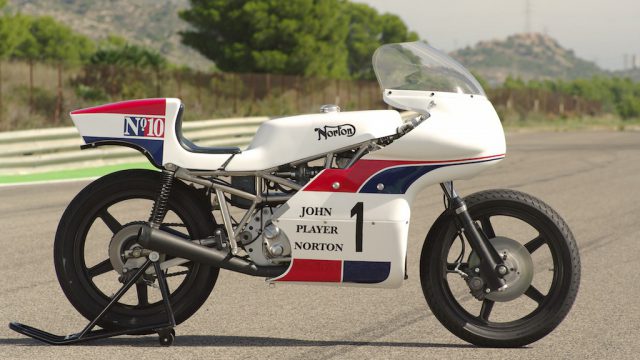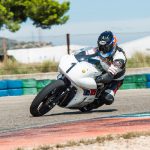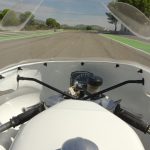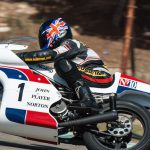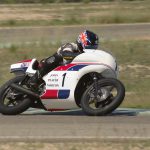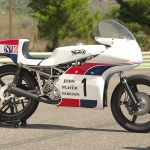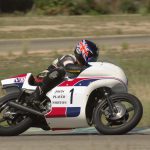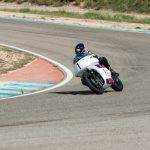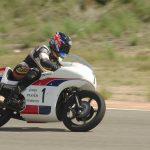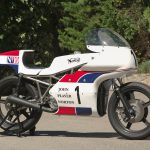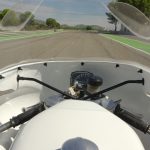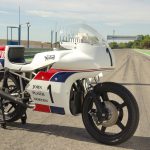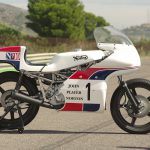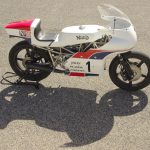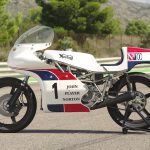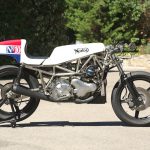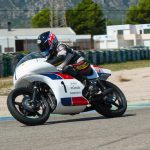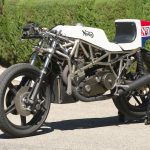Only journalist track test in 45 years of the 1974 John Player Norton 750 spaceframe
There are some moments you’ll never forget. About the most vivid road racing memory I have from my days as a spectator, having only recently screwed up enough courage to do the unthinkable and start racing myself, is of the 1974 Race of the Year at Mallory Park. The advent of the TZ750 Yamaha that year had sounded the death-knell of the four-strokes in the Formula 750 class, and Peter Williams' terrible accident at Oulton Park the previous month had knocked the stuffing out of the John Player Norton team, leaving the man who was arguably the greatest combination of rider and development engineer ever to throw a leg over a bike, with severe injuries that resulted in his losing the use of his left arm.
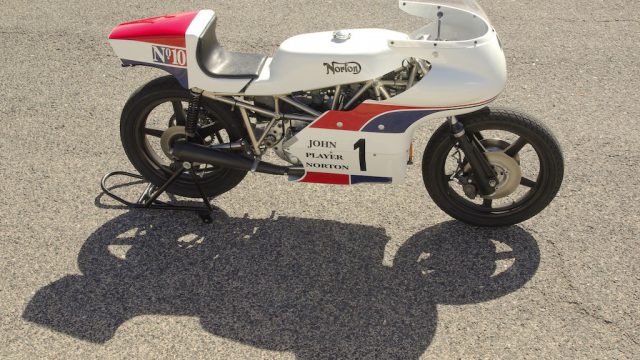
It seemed pretty hopeless for the four-banger brigade, then, although reigning 500cc World champion Phil Read was there on the MV Agusta four he’d won that year’s 500GP title on, as well as the previous season’s Race of the Year. Stella and I were watching from the bank at the entrance to the long, fast 180-degree Gerards right-hand horseshoe, and as the flag fell a cloud of 'stroker smoke' arose as front wheels of 120 bhp triples and fours pawed the air. It was a pretty miserable day with a slightly greasy track, and through the murk the expected leaders jostled their way into Gerards, Turn 1 on the short Mallory Park track. Sheene and Smart on the Suzuki triples, Kenny Roberts and Giacomo Agostini on the factory Yamahas, and Mick Grant's H2R Kawasaki – Japanese two-stroke multis, all. Suddenly, there was a much deeper rumbling exhaust note in evidence – and a flash of white leathers atop a candy-striped white machine. It was the inimitable Dave Croxford on the air-cooled John Player Norton parallel-twin, giving away over 40 bhp to his rivals and now the main hope of the Andover-based equipe after Williams' accident, determined as ever to wave the four-stroke banner together with the Union Jack.
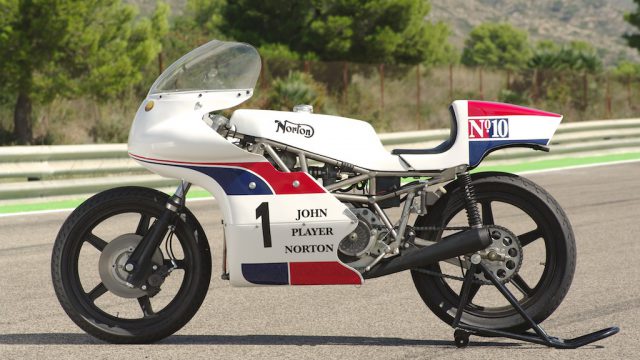
Crox always rode with an open-face helmet, and even in the gloom you could see his gritted teeth set in determination, his mind intent on reaping the utmost advantage on this long, long corner where the JPN's undoubted handling abilities could pay off. Rushing past gaggles of slower riders on the approach, he lined himself up about two inches from the left-hand grass verge, cranked the bike over to an impossible angle, and opened the throttle wide in those pre-traction control days. It was unforgettable. From about 8th into the corner, he started to pass one rider after another around the outside – you could actually see the Norton’s rear wheel stepping out of line as it scrabbled for grip on the limits of adhesion, but still Crox kept the power screwed on hard. Suddenly the crowd all around us became aware we were watching something we'd never forget. Someone took up the chant – and next thing we were all shouting out in unison as the JPN swooped past first one rider, then another: "Fourth …..third…..second", we shouted in ecstasy – then "FIRST!!!" as Dave streaked past a no doubt astonished Barry Sheene on his Suzuki triple to lead the pack down the back straight, past the Mallory lake and into the Esses. Flat on the tank, the rider and machine merged into one white streak, but inexorably the pack of strokers rushed past again, with Ago on his Daytona 200-winning 750 Yamaha – no doubt wishing he had a combination of his own machine's power and the Norton's handling at his disposal, – hitting the front to lead at the end of the first lap.
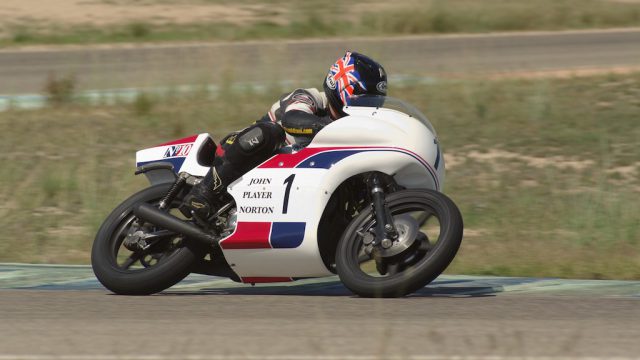
Croxford finished a superb 5th in that Race of the Year behind winner Barry Sheene, and had we but known it, we were watching the swansong of the John Player Norton team, which had given British racing fans so much to shout about for the previous three years. At the end of that season, the cigarette company’s three-year sponsorship deal with Norton ended and it withdrew its support, as the Andover race team laboured abortively on the liquid-cooled Cosworth-engined Challenge, before being dragged under by the financial demise of its parent NVT company. It was a sad ending to the tale of the team whose efforts had deserved so much more – yet had successfully taken on the might of the Japanese factories with an obsolescent air-cooled twin cylinder ohv four-stroke that was, however, clothed in a series of frames which nonetheless made maximum use of available technology, within the rigours of a tight financial budget.
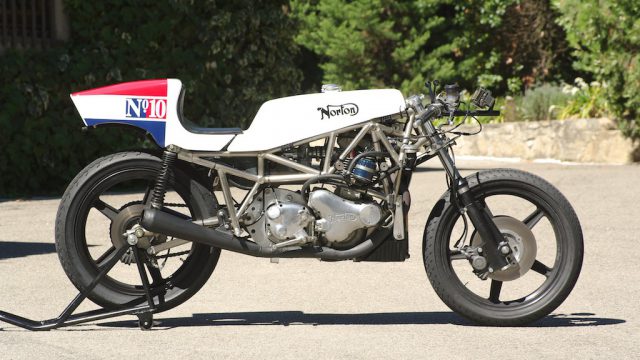
If on that murky Mallory afternoon back in 1974 you'd have told me that one day I'd get to ride the spaceframe JPN on which Dave Croxford had thrilled us all, I'd have questioned your sanity. But thanks to the generosity of the bike’s present owner, Barcelona-based Spanish enthusiast Joaquín Folch, I’ve been able to do so on several occasions ever since riding it for the first time at Donington Park’s 50th Anniversary meeting in 1981, when a parade brought the cream of the big F750 bikes of the early ‘70s and many of their riders together for the first time since their heyday a decade earlier. And when as an added bonus Peter Williams was there to drop the flag on that parade, it was the first of many opportunities I’ve had since then to talk to him about the bikes he had so much of a hand in creating, and which carried him to TT and short circuit victories galore. I even raced the JPN Spaceframe myself once in a CRMC event at Snetterton, and also lapped the Isle of Man’s Mountain Course on it exactly two decades ago in the 1998 TT Parade, alongside Joaquin on his freshly-rebuilt JPN Monocoque on the 25th anniversary of Peter Williams’ historic TT win in 1973 on that very bike. So the chance to ride the recommissioned JPN Spaceframe at a recent test day at the Calafat circuit south of Barcelona, was like meeting up with an old friend again – one which had benefited from being spruced up mechanically by the Can Costa Collection’s resident engineer, Carlos Guirado.
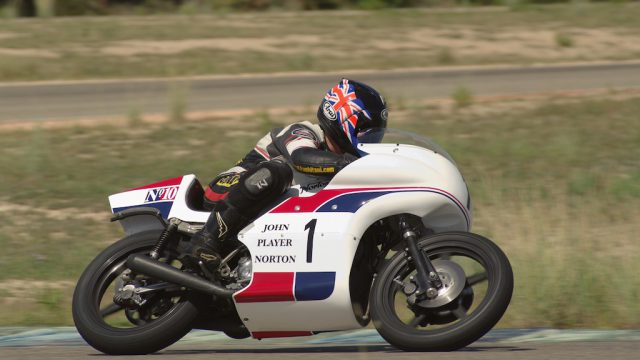
Each time I come to ride the JPN Spaceframe, my first reaction is always how improbably small it seems for a 750 – yet how relatively spacious it is compared to the two previous generations of John Player Norton which preceded it. Like its predecessors, the ’74 Norton appears low and little – more like a 500 than anything bigger, yet without being as cramped to ride as the ‘73 TT-winning Monocoque, which was essentially tailored to Peter Williams’ stature. I’ve been fortunate to ride both of Joaquin’s previous JPN iterations designed by Peter, as well as his Arter-Matchless which provided the template for them, and on all three in order to achieve their reduced frontal area you must ride with your hands very close together, rather like a track cyclist, and for the same wind-cheating reasons. In slow turns especially this gives someone unused to this a sense of not being in full control of the bike, simply because you don’t feel you have sufficient leverage on the ‘bars to steer the bike properly.. It’s very much an acquired skill.
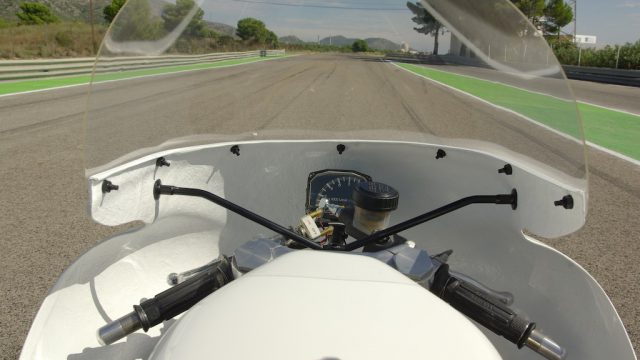
The ’74 Spaceframe is a fair bit more ‘normal’ – rational, even, with what feels to be a conventional set of tripleclamps, though the fact that there’s the same all-enveloping Peel-style fairing enclosing your hands as on the Monocoque makes it impossible to run-and-bump the Norton to start it. You have to sit aboard while someone pushes you, but then the 1970s’ F750 class was the first to have clutch starts at international level, rather than the dead engine type which persisted in GP racing for another decade. But this short-stroke Commando-based motor fires up very easily when you drop the light-action clutch, with a lovely grunty roar from the twin open meggas imparting the unmistakeably muscular sound of a tuned British parallel-twin.
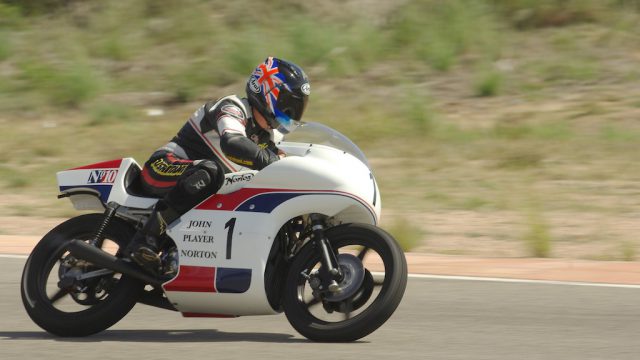
Once aboard you discover the Norton’s seat to be improbably comfortable, thanks partly to the carefully shaped curve to it into which you snuggle your bum as you crouch down over the low fuel tank to tuck behind the all-enveloping screen, while reaching out to the fully-enclosed handlebars that are quite steeply inclined. The footrests are a little lower than on the Monocoque, or maybe the seat’s a fraction higher – either way, it’s a little more spacious, although you do feel you’re sitting in rather than on the bike, almost as much enveloped by the bodywork as on the less spacious Monocoque. The seat’s reasonably thick padding by racebike standards is also a comfort factor, as I remember thinking on my lap of the TT Course aboard the Norton as I thundered along the Cronk-y-Voddy Straight or Mountain Mile, where the ride got distinctly lively thanks to the lack of rear wheel travel, and less than ideal damping by modern standards from the twin Koni shocks. But even on Calafat’s short main straight I could stretch out across the tank to tuck down behind the screen, and at the TT it soon became second nature to do that on fast stretches, then slide forward in the seat when I sat up under braking for a turn, or to get a better sight for the apex of a corner I didn’t have to brake for, like Black Dub, where just rolling off the throttle and letting the engine braking come into play was all I needed to do, especially at Parade speeds.
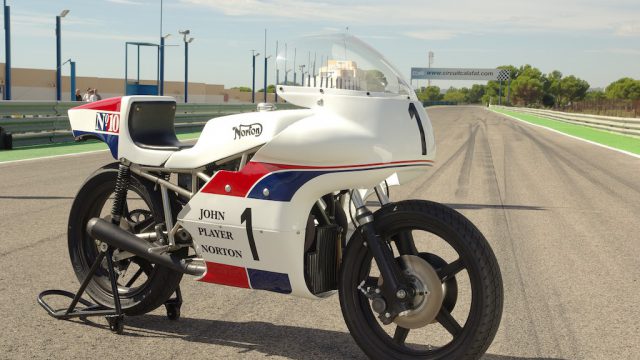
Unlike on the Folch-owned Monocoque JPN, whose brakes even by the standards of 45 years ago were a disappointment, the two-piston Lockheed calipers gripping the twin 10.5in/267mm Norvil cast iron discs on the Spaceframe bike had the same kind of bite as on the Ducati 750SS I used to race back then and still parade today. I was really impressed – relieved, even! – with how well it stopped even without using any significant engine braking, for fear of chattering the rear wheel on the overrun. There’s good feedback from the front discs via the brake lever, so no risk at my calmer pace of locking the front wheel as Peter Williams says he occasionally did in the heat of action in short circuit strife, and compared to the stainless steel discs on Japanese bikes back in the ‘70s, these would have been light years better in terms of response and feel.
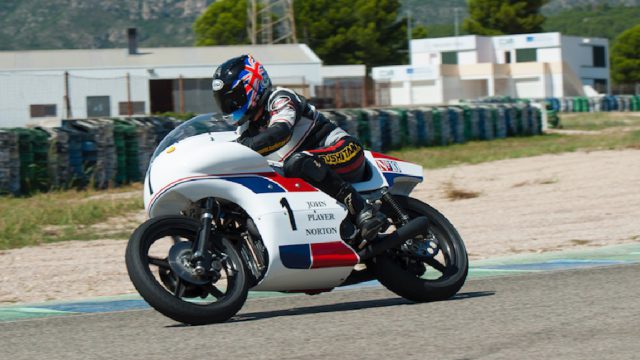
It doesn’t take long to discover the true charm of this JPN’s tuned-up short-stroke twin-cylinder Commando motor, which is its great rideability in spite of the extra performance it delivers compared to the longstroke version used previously. Somewhat improbably, that engine in the Folch ’72 Pannier-tank bike is actually peakier and less forgiving than this one, with a 5,400 rpm threshold for strong power. The short-stroke version in the ’74 Spaceframe is more flexible and definitely punchier, pulling from practically nothing up to 4,000 rpm, when a noticeable surge of extra power comes in fairly suddenly but still controllably. In no time at all the Kröber tacho that’s the only instrument in the sea of white inside the fairing is reading 7,300 revs, and it's time to change gear on the one-up, right-foot, rod-linkage lever. Unusually, the ever-present vibration which is an inevitable feature of such an engine with a two-up 360º crankshaft didn't seem to get any worse the higher you rev it, though you certainly can't ever forget you're riding a British-built parallel twin with no balance shafts, which leaves your extremities tingling for a few minutes after dismounting the bike. But, the JPN’s rubber Isolastic engine mounts do make a considerable difference to rider comfort, as I know from having ridden a Seeley-framed Kuhn Norton 750 racer with a rigidly-mounted engine. I'm still recovering!
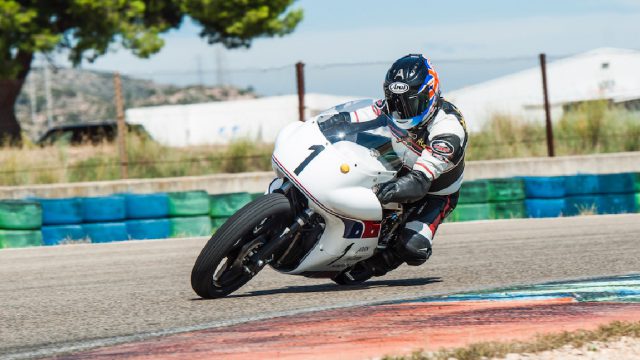
The transmission on the Spaceframe JPN features the redesigned primary drive for 1973 incorporating an extra outrigger bearing as well as a dry clutch, which together with speeding up the gearbox and fitting a crankshaft located shock absorber in the transmission, removed any reliability concerns – a fact well illustrated by Benjamin Grau winning all four races held on the gruelling stop-and-start Spanish street circuits of the early ‘70s en route to the 1975 Spanish F750 title on this Spaceframe bike, whose gearbox is very satisfying to use, with a light, smooth clutch action which can easily be worked with a pair of fingers, two-stroke GP-style, if you prefer. It’ll let you keep the engine working in its optimum power-band just by slipping it slightly exiting a tight corner like the Calafat hairpin at the end of the main straight.
Last gasp of Britain’s most famous racing brand until the Norton name was successfully revived 15 years later with the all-conquering Rotary racer
That's an important benefit, because it means you can avoid having to use bottom gear which, though higher on the five-speed Quaife close-ratio gearbox than on a standard Commando road transmission, is low enough to mean chattering the rear wheel if you change into it at racing speeds on the overrun, even into such a slow bend. Moreover, there's quite a gap between first and second gears, although the rest of the ratios are pretty close together. So it’s best to use second gear for even the slowest of turns, which makes you appreciate the light clutch action all the more, as you slip it slightly to get good drive – something that a Spanish 50/125GP two-stroke ace like Grau who raced the bike in Spain would have been quite used to doing!

But perhaps the Spaceframe Norton’s best feature is the way it steers, with the same identical front end fitted to the '74 JPN as to the Monocoque, with the same steering geometry, and the result is positive, light controllability, aided by the relatively short 1410mm wheelbase – though that may have been another factor in why it was so lively over the bumps on the TT Course. Nevertheless, within the limitations of the twin-shock rear end’s reduced suspension travel, the Spaceframe JPN copes well with any bumps you meet cranked over on the angle. The fork is pretty responsive and works quite well, but by modern standards the twin Koni shocks don’t have much travel, though that's not so much a problem on a smooth short circuit like Donington or even Calafat, as it undoubtedly was in the Isle of Man. Thanks to the low cee of gee it’s both stable over bumps and reasonably quick-steering, with you parked in place aboard the seat rather than hanging off the bike to help it to steer, as was not yet the fashion in those pre-knee slider days. I remember this was especially the case at the Donington chicane, where the low centre of gravity by the standards of most other machines and positive steering made getting through with the minimum of fuss easy to do. And it was super-stable round long, fast, fourth or fifth-gear sweepers, especially taken hard on the throttle. I can quite see now how Crox used to sail round the outside of his two-stroke rivals with such consummate ease.
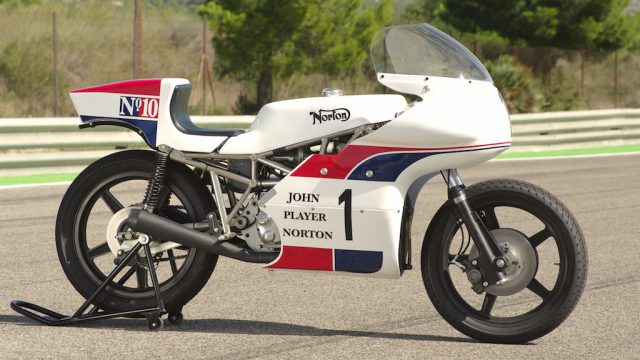
Let Peter Williams – rider and engineer extraordinary – have the last word, as I recorded in an interview with him at Donington back in 1981, the first time I rode the JPN Spaceframe. "The John Player Norton proved that a racing motorcycle really isn’t just all about horsepower,” he said. “Just like the Guzzi singles before us, or the 350 Yamahas up against the 750 Suzukis and Kawasakis, we demonstrated that a 78 bhp four-stroke twin could be competitive with two-strokes producing 120 bhp and more, simply by ensuring a clear advantage in other areas than horsepower which, if you work on them hard enough, will eventually give you an edge. That's why I admire intensely what Honda have been doing with their NR500 V4 four-stroke – it's simply a latter-day, high-technology version of the JPN, backed by a great deal more money than we ever dreamt of having – good luck to them, I say, because it adheres to the same precepts that we struggled so long to uphold at JPN. If we eventually strayed away from them, that was our fault, and we deserved to fail as a result. Meanwhile I can live with the knowledge that results proved my ideas and designs to be correct.”
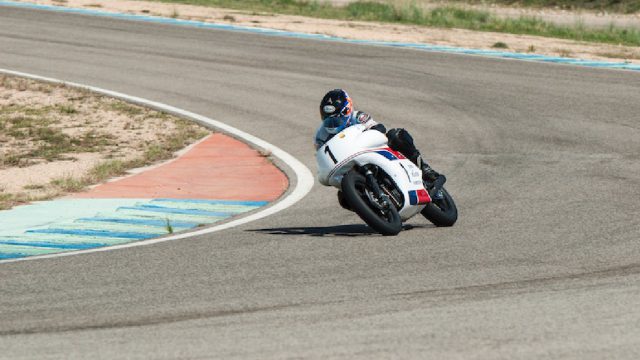
Two years later, having jettisoned the NR500, Honda would win the 500cc World Championship with a smaller, better-handling three-cylinder two-stroke that was more agile but less powerful than its four-cylinder rivals. Sadly, Norton was unable to attempt the same feat in Formula 750 with its Cosworth-engined Challenge – but like Honda it took a radical change of direction technically to produce a bike later on that was good enough to win the British Superbike Championship and the Isle of Man Senior TT. That machine was the legendary Rotary racer, making the Spaceframe JPN the company’s final drink at the last chance saloon for another two decades. Was it a failure, as Peter implies? That would be too harsh. It was simply a victim of circumstance, as two-stroke development continued, and the balance of power changed.
You can also read: Harley-Davidson issues massive recall
